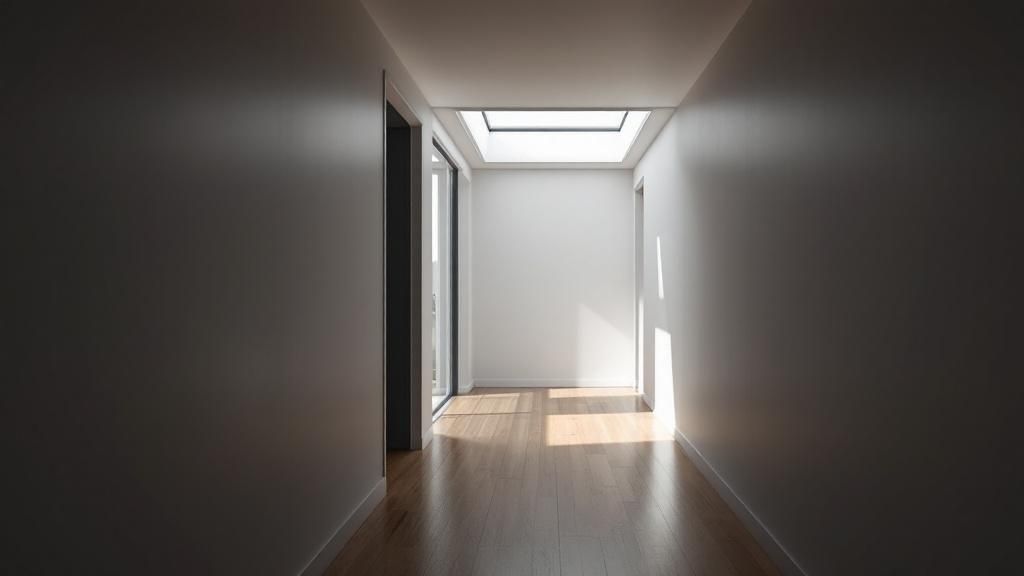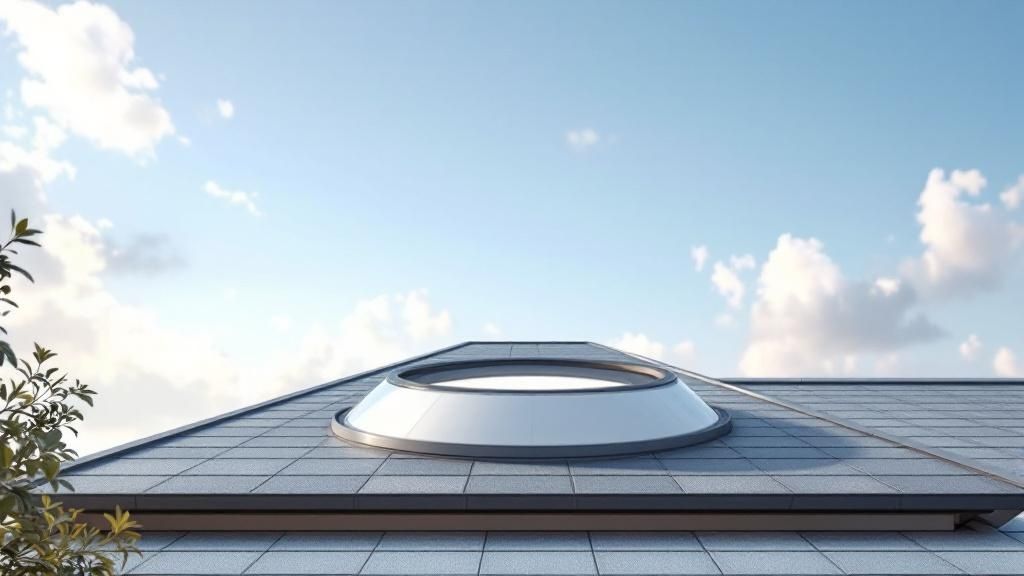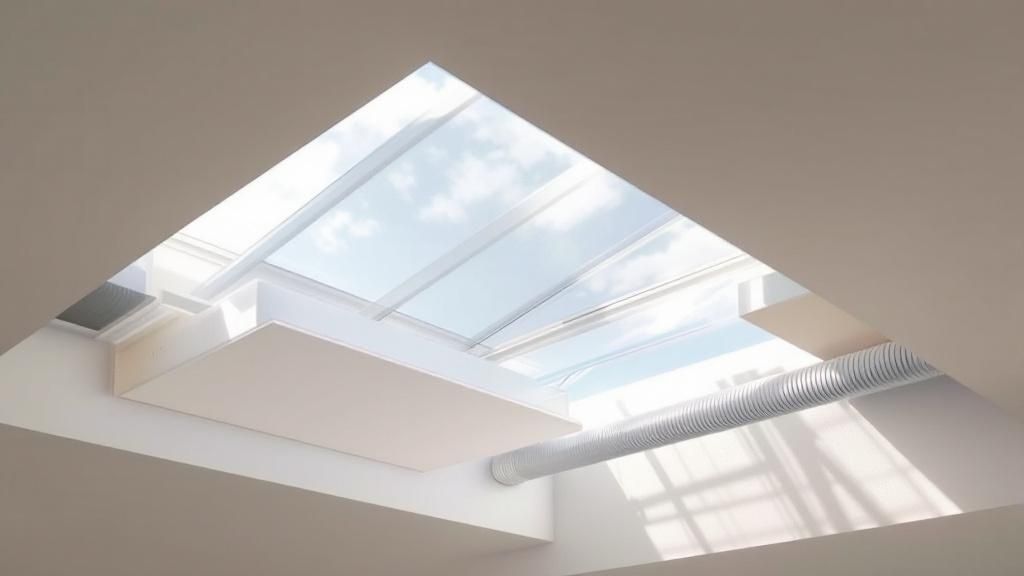
Understanding Sunlight Tunnel Skylights (Australian Innovation)

Sunlight tunnel skylights, also known as tubular skylights, are a popular way to brighten Australian homes with natural light. These systems capture sunlight on the roof and channel it down a reflective tube, illuminating even the darkest rooms. This can be a significant advantage for spaces lacking traditional window access. Let’s explore how these systems work and their growing popularity in Australia.
How Sunlight Tunnel Skylights Work
These clever systems use a few key components to maximize light capture and transfer. The process begins with a roof-mounted dome, designed to capture sunlight even on overcast days. This dome is strategically placed to optimize sunlight collection throughout the day.
The captured sunlight then travels down a highly reflective tube. This specialized tube minimizes light loss, ensuring maximum brightness reaches the interior of your home. Finally, a ceiling diffuser distributes the light evenly, creating a natural and welcoming atmosphere.
This process effectively mimics natural light from a traditional window, but with the ability to reach areas where windows aren’t an option.
Key Advantages of Sunlight Tunnel Skylights
Sunlight tunnel skylights offer several benefits that make them a strong alternative to traditional lighting:
- Energy Efficiency: By using natural sunlight, these skylights reduce the need for electric lights, leading to lower energy bills. This is especially beneficial in sunny Australia.
- Improved Natural Light: They provide consistent, bright natural light throughout the day, creating a more welcoming and spacious feel, even in smaller rooms.
- Versatility: Suitable for a variety of spaces – hallways, bathrooms, kitchens, and rooms without windows – their compact design allows for flexible placement. This adaptability works well for Australian homes of all shapes and sizes.
- Easy Installation: Sunlight tunnel skylights are typically quicker and easier to install than traditional skylights, minimizing disruption to your home. This is a key advantage for retrofitting existing houses.
The combination of practical advantages and improved aesthetics has made sunlight tunnel skylights an increasingly common choice. Their growing popularity reflects a trend towards brighter, more sustainable, and healthier homes across Australia.
Market Trends Driving Sunlight Tunnel Skylight Adoption

The growing interest in sunlight tunnel skylights reflects a significant shift in how Australians illuminate their homes. It’s not just about aesthetics; it’s about embracing sustainability, saving money, and improving overall well-being. This increasing demand highlights a broader trend toward environmentally friendly and energy-conscious living.
The Rise of Sustainable Living
A major factor driving this trend is the increasing awareness of environmental responsibility. Australian homeowners are actively looking for ways to minimize their environmental impact. Sunlight tunnel skylights offer a practical solution by utilizing natural light. This reduces reliance on electricity, leading to lower energy consumption and fewer greenhouse gas emissions.
This approach strongly appeals to environmentally conscious consumers. They view these skylights as a concrete step towards a more sustainable future.
Electricity Costs and Energy Independence
Rising electricity prices are another reason homeowners are exploring cost-effective lighting options. Sunlight tunnel skylights offer a way to substantially reduce daytime electricity use, resulting in noticeable savings on utility bills.
For instance, a strategically placed sunlight tunnel skylight can eliminate the need for electric lights in a hallway or bathroom during the day. This added benefit of energy independence further boosts the appeal of these skylights. You might be interested in: How to master your skylight’s energy efficiency.
The global market for tubular skylights is also experiencing significant growth, reflecting the increased focus on sustainability. The market was valued at approximately USD 479.6 million in 2024 and is projected to grow at a CAGR of 5.4% over the next decade. Find more detailed statistics here. This demonstrates the growing global acceptance of sustainable building solutions like sunlight tunnel skylights.
Government Incentives and Building Codes
Government programs also play a role in encouraging energy-efficient home upgrades. Various rebates and incentives are available across Australia for homeowners who invest in sustainable building practices, including the installation of sunlight tunnel skylights. These programs make these eco-friendly options more affordable and encourage wider adoption.
Technological Advancements
In addition to these market drivers, continuous technological advancements are improving the performance and attractiveness of sunlight tunnel skylights. Innovations in reflective tube materials maximize light transmission, while advancements in diffuser technology ensure uniform light distribution. Some models now offer adjustable diffusers, giving homeowners control over the intensity and direction of natural light.
These combined factors – a growing emphasis on sustainable living, increasing energy costs, government support, and ongoing innovation – are driving the adoption of sunlight tunnel skylights in Australia. This trend is expected to continue as more homeowners recognize the advantages of brighter, healthier, and more energy-efficient homes.
Your Complete Sunlight Tunnel Skylight Installation Guide
Installing a sunlight tunnel skylight can feel overwhelming. Understanding the process, however, empowers you to make informed decisions and work effectively with your installers. This guide breaks down the installation journey, from the initial roof assessment to the final tests.
Assessing Your Roof and Planning Placement
The first step is a comprehensive roof assessment. This includes evaluating its structural integrity, slope, and orientation. In Australia, a south-facing roof typically maximizes sunlight capture. East and west-facing roofs can also be suitable.
The dome’s placement should be clear of obstructions such as trees or buildings. Accurately marking the ideal spot on both the roof and ceiling ensures proper alignment for the reflective tube.
Consider your home’s internal layout to optimize the natural light. Placing the diffuser over a hallway, for example, can brighten a traditionally dim space.
Roof Cutting, Dome Installation, and Tube Insertion
Next is the core installation phase. Certified installers are crucial for safety and warranty compliance. Learn more in our article about How to install a skylight. The infographic below illustrates the key steps involved in installing a sunlight tunnel skylight: planning and placement, roof cutting and dome installation, and finally, inserting the reflective tube and ceiling diffuser.

This methodical process, as shown in the infographic, ensures proper installation. From careful initial planning, the installation moves to the roof work and concludes with interior finishing touches. This minimizes disruption and ensures efficient light transfer.
The installer cuts the necessary openings in the roof and ceiling. They secure the dome, ensuring a weathertight seal to prevent leaks. The reflective tubing is then carefully inserted and connected to both the dome and the diffuser. Experienced installers can effectively handle the challenges of tight roof spaces and various roof materials (tiles, metal sheeting, etc.).
Finishing Touches and Final Checks
With the tube in place, the ceiling diffuser is installed and secured. The diffuser distributes natural light evenly. The installer then conducts a final check, confirming correct light output and ensuring all components are sealed and secure. Now you can enjoy the benefits of natural light!
Council Approvals and Building Regulations
Before any installation, check local council approvals and building regulations. Some areas have specific requirements for skylight installations, especially regarding roof modifications. Professional installers are familiar with these regulations and can assist with the necessary paperwork and compliance procedures. Knowing these requirements upfront prevents potential problems and ensures your installation meets all standards.
Installation Timeframes and DIY vs. Professional Installation
Professional installation usually takes a few hours, depending on the roof and ceiling structure’s complexity. While DIY enthusiasts can handle some preliminary work, certified installers should always manage tasks involving roof penetration and weatherproofing. This ensures safety and protects your warranty. A professional approach offers peace of mind and a guaranteed, high-quality result.
To help illustrate installation requirements, let’s look at the following table:
Installation Requirements by Roof Type
Comparison of installation considerations for different Australian roof types including tile, metal, and flat roofs
| Roof Type | Installation Complexity | Average Time | Special Requirements |
|---|---|---|---|
| Tile | Moderate | 4-6 hours | Securing tiles around the dome, specialized flashing |
| Metal | Moderate | 3-5 hours | Correct sealant for metal roofing, potential reinforcement |
| Flat | Relatively Simple | 2-4 hours | Proper drainage considerations, appropriate flashing |
This table summarizes the key differences in installation based on roof type. As you can see, each roof type presents unique considerations impacting installation time and complexity. Consulting with a professional installer is crucial for determining the specific requirements for your roof.
Smart Investment Analysis For Sunlight Tunnel Skylights

Thinking about a sunlight tunnel skylight? The true cost goes beyond the initial price. It’s about the long-term value and return on investment. Let’s break down the expenses, explore potential savings, and see how natural light can impact your finances.
Initial Costs: Product and Installation
Upfront, you’ll have product and installation costs. Prices depend on the brand, size, and features. Solartube, for instance, offers its Brighten Up series, generally priced between $1000-$1800 depending on the system and installation. This pricing reflects the quality and performance, designed for maximum natural light and energy efficiency. Professional installation, especially for roof work, is highly recommended. Installation costs vary based on the job complexity, roof type, and accessibility.
Long-Term Savings: Energy Efficiency
A major advantage of sunlight tunnel skylights is energy savings. By using natural light, you’ll depend less on artificial lighting, leading to lower electricity bills and a solid return on investment. Your savings depend on the skylight’s size and placement, your climate, and energy habits. But even small cuts in electricity use add up over time.
Property Value: Enhancing Your Home’s Appeal
Sunlight tunnel skylights not only save energy but also boost your property value. Natural light is a huge draw for buyers. It makes interiors brighter, creates a welcoming feel, and can even make rooms seem larger. These factors can significantly increase your home’s market appeal.
Financing and Rebates: Making It Affordable
Financing options can help manage the initial costs. Plus, check for government rebates and incentives for energy-efficient upgrades. These options can make the investment more manageable and speed up your return.
Payback Period: Calculating Your Return
The payback period—the time it takes for energy savings to offset the initial cost—depends on the skylight’s cost, your energy savings, and any rebates. For window covering installation guidance, see this guide. Usually, a sunlight tunnel skylight pays for itself fairly quickly through lower energy bills and potentially higher property value.
Cost-Benefit Analysis: A Long-Term Perspective
For a long-term view, consider a cost-benefit analysis. This compares the initial investment and maintenance costs with the cumulative energy savings and potential property value increase over a set time. This gives a clearer picture of the financial implications.
To illustrate the long-term financial benefits, let’s look at a simplified example:
Cost-Benefit Analysis Over 10 Years
Financial comparison showing initial investment versus cumulative energy savings and increased property value
| Year | Cumulative Energy Savings | Maintenance Costs | Net Value |
|---|---|---|---|
| 1 | $100 | $20 | $80 |
| 5 | $500 | $100 | $400 |
| 10 | $1200 | $200 | $1000 |
This is a simplified example and actual figures will vary. This example shows how cumulative savings can substantially outweigh maintenance costs, leading to a positive net value.
By weighing these factors, you can decide if a sunlight tunnel skylight is right for you. Remember, actual numbers will vary, so consulting a professional is recommended for personalized advice.
Beyond Lighting: Health and Home Value Benefits
Sunlight tunnel skylights offer more than just brightness; they provide a range of benefits that improve both your well-being and your home’s value. These advantages extend beyond simple illumination, impacting your health, mood, and even your property’s resale potential.
Natural Light and Your Well-being
Natural light is essential for our physical and mental health. Exposure to sunlight helps regulate our circadian rhythms, affecting sleep patterns and overall mood. By bringing natural light indoors, sunlight tunnel skylights can help counteract the effects of limited sunlight exposure, particularly beneficial for those working from home. This can lead to improved sleep, increased energy, and a more positive outlook.
For instance, a sunlight tunnel skylight in a home office can dramatically improve focus and productivity by providing consistent, natural light throughout the workday. This is particularly advantageous in Australia, where sunshine is plentiful. Furthermore, natural light has been shown to lessen the symptoms of Seasonal Affective Disorder (SAD), a type of depression linked to seasonal changes.
Psychological Benefits of Natural Light
Beyond the physiological benefits, natural light positively affects our psychology. Studies have shown a connection between natural light exposure and reduced stress. Sunlight triggers the release of serotonin, a neurotransmitter associated with well-being and happiness. This means more natural light in your home can create a calmer, more relaxing atmosphere.
Bringing the outdoors in fosters a connection with nature, even inside. This can be particularly beneficial in urban environments or homes with limited outdoor access. Sunlight tunnel skylights effectively mimic the feeling of a window, making even small rooms feel larger and more inviting.
Improved Indoor Air Quality and Moisture Control
Sunlight tunnel skylights can improve indoor air quality, especially in damp areas. By increasing natural light and ventilation in spaces like internal bathrooms and hallways, these systems reduce moisture buildup and inhibit mold and mildew growth. This contributes to a healthier, more comfortable living environment.
For a different perspective on home safety investments, see: Fire Blankets: A Smart Investment for Home Safety
Impact on Home Value and Buyer Appeal
Financially, sunlight tunnel skylights are a wise investment. Natural light is highly desirable for potential homebuyers. Bright, airy spaces are seen as modern and appealing, increasing a home’s market value. This can be a key selling point, possibly leading to a faster sale and a higher price. See our guide on the benefits of skylights.
Conversations with real estate agents and property valuers confirm the positive impact of natural lighting on property valuations. Many buyers will pay a premium for homes with ample natural light. This makes sunlight tunnel skylights an attractive investment for homeowners wanting to increase their property’s value. They offer a tangible return on investment, extending beyond cosmetic improvements.
Choosing The Perfect System For Your Australian Home
With so many sunlight tunnel skylights on the market, finding the right one for your Australian home means understanding your needs and your home’s specific features. This guide will walk you through the essential things to consider, from room size and roof direction to diffuser types and warranties.
Assessing Your Needs and Home Characteristics
Before looking at specific products, take a good look at your home. Think about the size of your rooms and how high your ceilings are. Larger rooms might need wider tubes or even multiple skylights. Lower ceilings could require shorter tubes or specially designed diffusers.
Next, check which way your roof faces. South-facing roofs in Australia generally capture the most sunlight, though east and west-facing roofs can also work well. Are there any trees or buildings blocking the sun? Your local climate matters too. If you live in a cloudy area, you’ll want a skylight that’s designed to work well in low light.
Understanding Different System Components
Sunlight tunnel skylights have three main parts: the dome, the tube, and the diffuser. Each one is critical to how well the system works.
- Domes: Domes come in various shapes and materials, which affect how well they capture light. Some are made to capture maximum light, even on cloudy days.
- Tubes: The tube’s diameter influences how much light gets through. Reflectivity is also crucial – a more reflective tube means brighter light. Rigid tubes work best for straight installations, while flexible tubes are better for navigating around obstacles in your roof space.
- Diffusers: Diffusers control how light spreads in the room. Prismatic diffusers give even light distribution, frosted diffusers create a softer glow, and adjustable diffusers let you direct the light.
Key Features and Performance Ratings
Think about extra features beyond the basic components. Ventilation options can help control temperature and humidity. Dimming controls let you adjust the brightness throughout the day. Understanding light output is essential. Check the Visible Light Transmittance (VLT) ratings to compare different models.
Examining Warranties, Supplier Support, and Maintenance
A sunlight tunnel skylight is a long-term investment, so look beyond the initial price. A good warranty from the manufacturer indicates quality and durability. Local supplier support is important, especially if you need help with installation or future maintenance.
Finally, consider the maintenance. Most sunlight tunnel skylights are fairly low-maintenance, needing only occasional cleaning of the dome and diffuser. Choose a system with readily available replacement parts, just in case you need repairs down the line.
Maximizing Your Investment with Vivid Skylights
Choosing the right sunlight tunnel skylight can seem daunting. But by considering your needs, understanding the key features, and thinking about long-term factors like warranties and maintenance, you can make a smart choice that will brighten your home for years to come. For high-quality skylights designed for Australian homes, check out Vivid Skylights. Transform your dark rooms into bright, inviting spaces and see the difference natural light makes.
